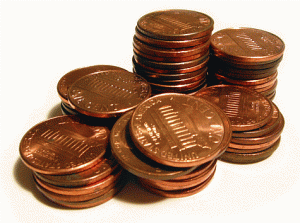Copper pennies and arbitrage (Retail Ventures and DSW).
My good friend Mike (here and here) recently left a comment about copper mines, which got me thinking about copper pennies. In 1982, the US Mint stopped making pennies out of 95% copper, and started making them out of copper-plated zinc. Even now that the price of copper dropped back down, copper pennies presently contain 1.8 cents worth of copper apiece. And some people are in fact sorting copper pennies out of the new zinc ones. Better than stealing copper from foreclosed homes, I suppose.
 Copper penny enthusiasts pride themselves on what they see as high returns on investment. I suppose, at a .8 cent premium and perhaps 20% of 95% copper pennies left in the typical mix, they see themselves as making 16% on each lot of pennies they get—if they place absolutely no value on their time. And making 16% on a handful of pennies is not like making 16% off a wise stock purchase. Now that melting pennies is illegal, it is even less easy to turn a dollar’s worth of pennies into $1.80 cents in copper, not to mention the expense of the melting. If they cannot ultimately realize the value of the copper they have made -20% by taking perfectly good pennies and hiding them away somewhere.
Copper penny enthusiasts pride themselves on what they see as high returns on investment. I suppose, at a .8 cent premium and perhaps 20% of 95% copper pennies left in the typical mix, they see themselves as making 16% on each lot of pennies they get—if they place absolutely no value on their time. And making 16% on a handful of pennies is not like making 16% off a wise stock purchase. Now that melting pennies is illegal, it is even less easy to turn a dollar’s worth of pennies into $1.80 cents in copper, not to mention the expense of the melting. If they cannot ultimately realize the value of the copper they have made -20% by taking perfectly good pennies and hiding them away somewhere.
But, where there’s a will there’s a way. There is a device called the Ryedale that can sort the two types of pennies out of each other, allowing people to get pennies in bulk from banks, run them through the machine, and fill their basements with copper coins at a vastly increased rate. It also puts banks to the trouble and expense of shipping a lot of very cheap coins around; after all, $100 in pennies weighs 64 pounds. Naturally, many of the penny people, unlike me, think a great deal about hyperinflation, but they almost seem to be looking forward to it. After all, in Zimbabwe during its hyperinflation they allowed old coins to trade at the new value when they revalued (i.e. chopped ten zeroes off of) their currency, which was a nice bonus. And, well, without hyperinflation turning all your money into copper pennies would seem like kind of an odd thing to do.
Well, everyone needs a hobby, but there are easier ways to get something for nothing. Retail Ventures Inc. (RVI), market cap of $163 million, owns 62.9% by value (and 93.1% by vote) of DSW, market cap of $565 million, and this relationship has curiously persisted for some time. This implies that the remaining assets of RVI are worth negative 192 million dollars, which is not really possible. Instead of arbitraging pennies, we could arbitrage these two companies by buying RVI and shorting 59% as many shares of DSW (one of RVI’s 50 million shares is one 75 millionth of DSW, and 44 million shares of DSW divided by 75 million is .59). By virtue of their relationship, the two companies are unlikely to permanently shoot off in opposite directions, and so the fructivore who makes this trade should profit when this value discrepancy is resolved. There is, of course, a risk that a corporate relationship is severed before then (unlike merger arbitrage, here the risk comes from the restructuring happening instead of not happening). You may also find it difficult to borrow the shares; DSW has a 28% short interest and because a lot of them are doing this arbitrage, it would take dynamite to dislodge them.
So, for the diligent fructivore investor, there are easier ways to wealth than by one copper penny at a time. But in all fairness I must admit that I found two silver dimes in my change within the last year, and I still look. But I look harder for valuable opportunities in the securities market.
Leave a Reply